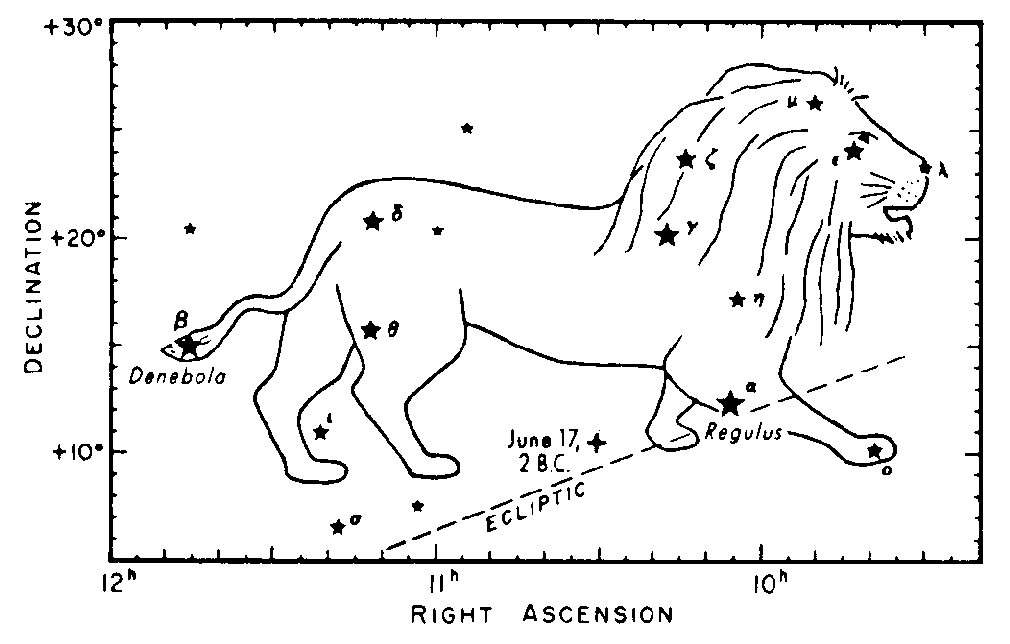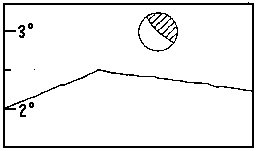
Reprinted from Meridian Magazine (Nov. 28, 2000)
©2000 by John P. Pratt. All rights Reserved.
While the exact nature of the Star of Bethlehem still eludes astronomers, the sign in the heavens of the conception of the Savior has now apparently been discovered.
Throughout the centuries, astronomers have puzzled over just what the Star of Bethlehem might have been. The story of wise men following a star which finally "stood over where the young child was" has evoked all manner of theories to explain it, including a nova or supernova, planetary conjunctions, a comet, flying saucer, angelic messengers or simply a special miracle. One of the best proposals for the Star of Bethlehem now appears much more likely to have been a sign of the conception of Jesus Christ, and to have been mentioned in the Book of Mormon.
The traditional way for astronomers to hunt for the Star of Bethlehem has been first to determine the date of the Savior's birth and then to search what is known about the heavens at that time in order to find a plausible "star." The Bible gives several clues about the time of the Savior's birth, but most of them have escaped detection in secular sources. For example, the slaughter of the infants by King Herod, a taxation which would require Mary and Joseph to visit Bethlehem, and the Star of Bethlehem itself have not been unequivocally identified. Almost entirely bereft of facts, historians have been forced to base the method for determining the Savior's birth on only one explicitly stated date by only one historian: the death date of King Herod the Great.
Both Matthew and Luke make it clear that Herod the Great was alive at the time of Jesus's birth and also for sometime afterward, when he had the infant boys killed. The Jewish historian Josephus gives a precise year for the beginning of Herod's actual reign, being the year now called 37 B.C. He later states that he reigned for 34 years from that date, stating that it was also 37 years from the time he was named king in 40 B.C. Both of those statements would put his death in 3 B.C. To the delight of astronomers and historians, Josephus also mentions that Herod died shortly after a lunar eclipse, and sure enough, one occurred in March of 4 B.C. Thus, Herod's death is placed in 4 B.C. The Savior's birth is then deduced to be in about 5-6 B.C. because Herod had infants killed from two years and younger from two years old and under, "according to the time which he had diligently enquired of the wise men" (Mat. 2:16).
When astronomers have searched the 6 B.C. skies, aided by computers which can calculate planetary positions for any date, they have found a conjunction of Jupiter and Saturn which looked like a promising possibility. Actually, the astronomer Johannes Kepler suggested that possibility, coupled with a "nova" or exploding star, centuries before computers were available. That suggestion has been the traditional story since Kepler, although it has also been noted that there was a comet in 5 B.C. which might better fulfill the description that "the star, which they saw in the east, went before them, till it came and stood over where the young child was" (Mat. 2:9). There has not really been any celestial event proposed which has been compelling, so astronomers (including this author) usually admit that they simply do not know what the star was.
The Book of Mormon adds the data point to the Biblical account that in the Western Hemisphere a new star appeared at that time, such as they had never beheld (3 Nep 1:21, Hel. 14:5). That phrase is generally taken to mean a bright, new star, which sounds like a nova or supernova. The Biblical account alone is usually interpreted that it was not a bright star because otherwise Herod's astrologers would have seen it. That argument seems invalid because it is more likely they did see it, but failed to grasp its significance, because "when Herod the king had heard these things, he was troubled, and all Jerusalem with him" (Mat. 2:3). Moreover, several other extra-Biblical sources specifically state that the star was very bright. If the star seen by the Nephites was the same as that seen in Jerusalem,then most likely the Star of Bethlehem really was a star rather than merely a conjunction of planets. When astronomers have checked the records, such as those of China, for an observation of a new star at that time, they have been disappointed.
A novel way of finding the star was proposed over thirty years ago which had remarkable results. It was acknowledged that the date of Christ's birth is so uncertain that it might be better to search that whole decade for the best possible planetary conjunction to be the Star of Bethlehem. One conjunction stood out as truly remarkable, which left all its competitors far behind. Accordingly the author proposed that the conjunction of Venus and Jupiter in June, 2 B.C. might have been the Star of Bethlehem, notwithstanding Herod's usually accepted death date.[1] Since then this conjunction has gained many supporters and Christmas planetarium shows often include it as a leading possibility to have been the Star of Bethlehem.
 |
Secondly, the conjunction occurred near Regulus, the brightest star in Leo, and the most important of the four bright "royal stars" of zodiac. Regulus means "The Prince" and is one of the many bright stars which was apparently symbolized Christ anciently. This star seems to emphasize his role as the Prince of Peace and King of Kings.
Third, the conjunction was between the two brightest planets, Jupiter and Venus. Jupiter or Zeus represented the Father of Gods (perhaps a pagan version of "Heavenly Father") and Venus or Isis represented the virgin mother of the infant god Horus who would come to reign, which sounds a lot like the virgin Mary.
Fourth, the conjunction was so incredibly close that the two planets actually appeared to touch each other. Moreover, both planets were are a very bright part of their cycles. Such a conjunction is extremely rare. Computer calculations indicate that there has never been a closer, brighter conjunction of Jupiter and Venus in the 2,000 years before and after the birth of Christ.[2]
Finally, from Jerusalem, the two planets appeared to descend to the earth after sunset as they touched:
"As the sky darkened this brilliant 'double star' sank lower, the planets drawing nearer and nearer. At last, just above the horizon, they fused into one, gleaming like a great beacon over Judea to the west."[1]
 |
The implications of an April 6, 1 B.C. birth for Christ for this spectacular sign in the heavens make it even more impressive and its meaning clear. If Jesus was born in April, 1 B.C., then the conjunction of Jupiter and Venus occurred at what would have been about the time of his conception in June of 2 B.C. Associating that conjunction with the time of the conception of Christ also dovetails with two ancient traditions mentioned by the fourth century Christian father Epiphanius. First, he held that the conception of Christ occurred on June 20, which is very close to the June 17 conjunction (Julian Calendar). Secondly, he also noted a tradition that Mary's pregnancy lasted ten months,[3] which is a perfect fit because the conjunction occurred ten lunar months before April 6, 1 B.C.
Thus, in the light of modern revelation of the precise day of Jesus's birth, it appears that the Jupiter-Venus conjunction of 2 B.C. was not the Star of Bethlehem, but was really the sign of the conception of Jesus Christ. Viewed in that context, the conjunction makes even more sense, with the Father planet and the Virgin Mother planet fusing into one as they descend to the earth. What more could be asked of a perfectly designed planetary sign to represent the conception of Jesus Christ? The Lord told Moses that the planets were designed for "signs" (Gen. 1:14) and this had to be one of the most impressive.
Thus, this conjunction, when interpreted in the framework of the symbolism of the ancients, becomes a witness to the time of the Savior's conception and indirectly of the Savior's birth date ten months later. The Book of Mormon adds its testimony also. Samuel the Lamanite prophesied that not only would a new star appear at the Savior's birth, but that "there shall be many signs and wonders in heaven" (Hel. 14:6). It then testifies that in the year or so before the Savior's birth, there were great signs and wonders observed: "it came to pass in the ninetieth year of the reign of the judges, there were great signs given unto the people, and wonders; and the words of the prophets began to be fulfilled" (Hel. 16:13). Exactly what would have been interpreted as a great sign in the heavens? It seems that this very rare conjunction would certainly qualify.
Thus, the heavens bear yet another wonderful record of the timing of one of the most important events in the history of the earth, the birth of the Savior Jesus Christ. Truly, "the heavens declare the glory of God; and the firmament sheweth his handywork" (Psalms 19:1).